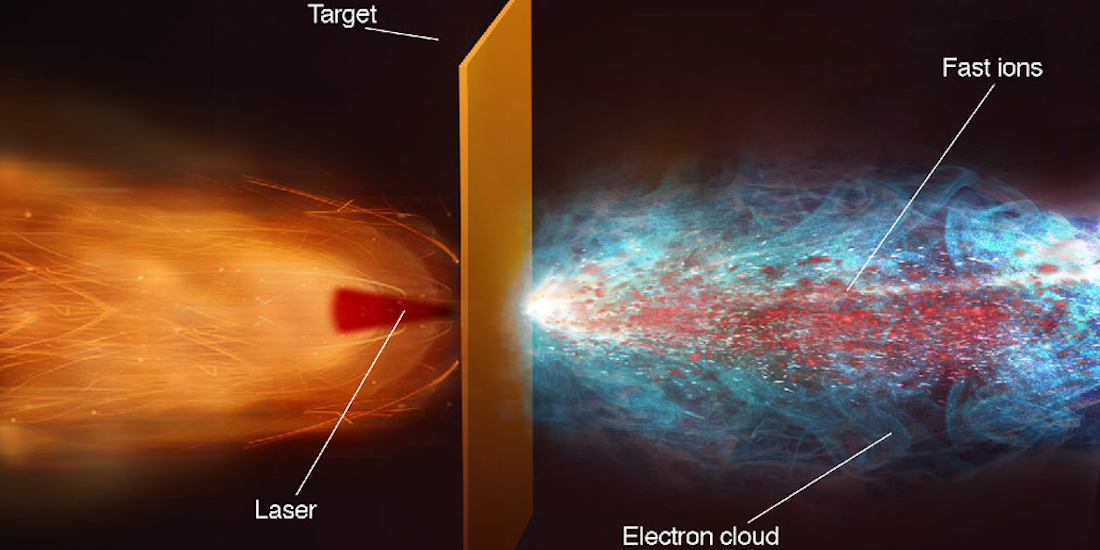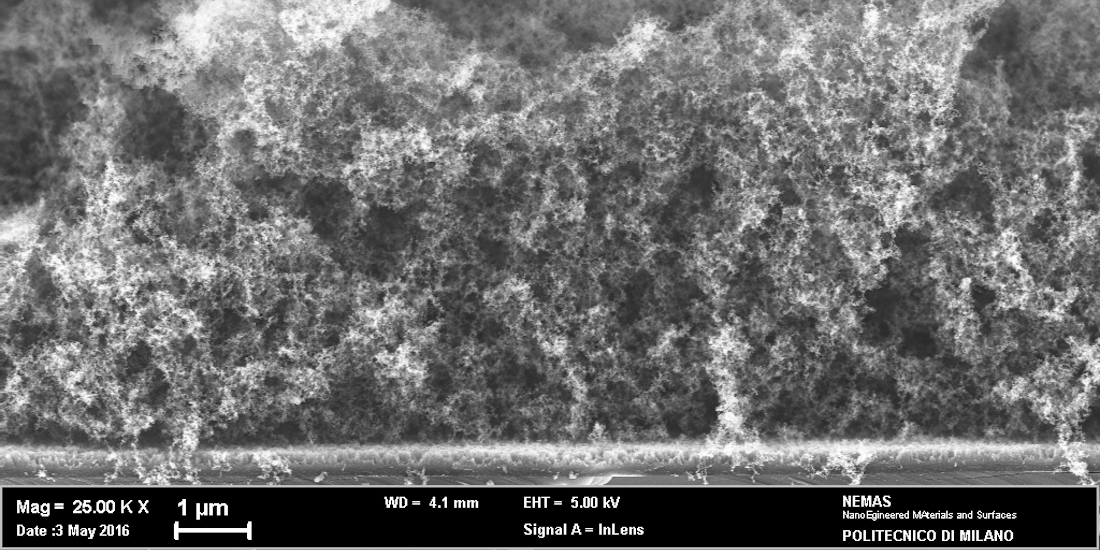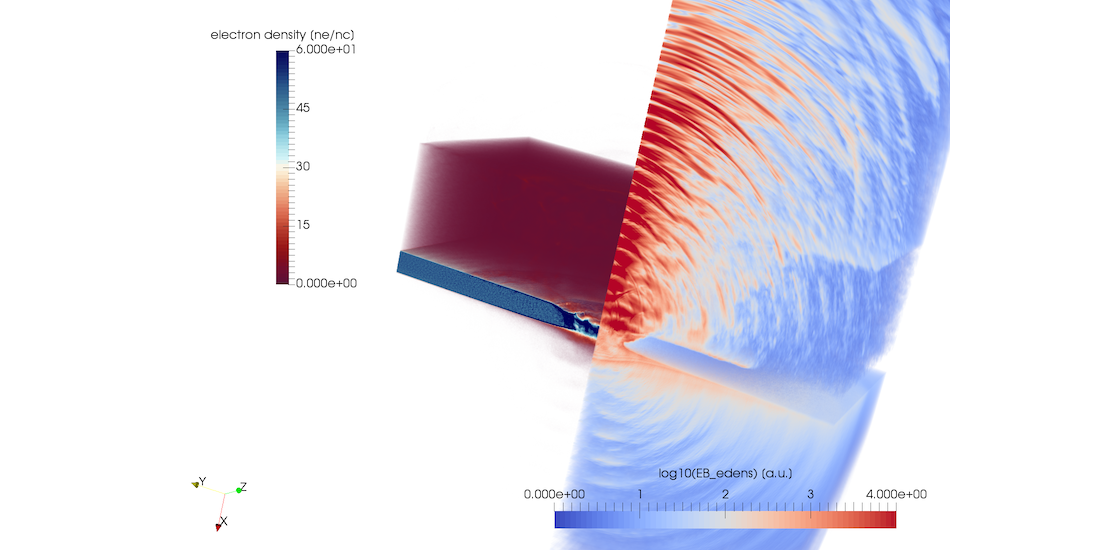One of the most active and innovative areas of laser and plasma science with challenging experimental and theoretical issues. [Rev. Mod. Phys. 85.2 (2013): 751]
Home
Welcome to the ENSURE project website!
ENSURE was a 5-year (2015-2020) multidisciplinary research project for the investigation of ion acceleration through the interaction between superintense laser pulses and nanostructured materials, funded by the European Research Council (Grant Agreement 647554) and hosted at the Department of Energy of Politecnico di Milano (Italy) under the supervision of the principal investigator prof. Matteo Passoni. Click on the button to find out more about the project!
This website is currently updated with the research in the wake of the ENSURE project, the related PoC project INTER and the recently approved PoC project PANTANI.




A multidisciplinary approach!
To achieve our goals, many experimental and theoretical challenges need to be faced within different fields of research in a multidisciplinary approach. Find out more about each of them.
Latest News
Press release on Politecnico di Milano’s website
The Politecnico di Milano published a press release on the …Read More »ENSURE has come to a successful end
After 5 years of fruitful work, the project ENSURE is …Read More »
Latest Publications
Mirani, F.; Ambrogioni, K.; Maffini, A.; Gatti, F.; Magistris, M. S. Galli De; Galbiati, M.; Vavassori, D.; Orecchia, D.; Rastelli, D.; Mazzucconi, D.; Dellasega, D.; Russo, V.; Henares, J. L.; Morabito, A.; Pérez-Hernández, J.; Apiñaniz, J. I.; Ehret, M.; Cebriano, T.; Volpe, L.; Pola, A.; Passoni, M.
Addressing the role of advanced targets for enhanced control of laser-driven hadron sources Journal Article
In: Physical Review Applied, vol. 24, no. 014017, 2025.
@article{nokeyh,
title = {Addressing the role of advanced targets for enhanced control of laser-driven hadron sources},
author = {F. Mirani and K. Ambrogioni and A. Maffini and F. Gatti and M. S. Galli De Magistris and M. Galbiati and D. Vavassori and D. Orecchia and D. Rastelli and D. Mazzucconi and D. Dellasega and V. Russo and J. L. Henares and A. Morabito and J. Pérez-Hernández and J. I. Apiñaniz and M. Ehret and T. Cebriano and L. Volpe and A. Pola and M. Passoni},
url = {https://doi.org/10.1103/vh27-ztj1},
doi = {10.1103/vh27-ztj1},
year = {2025},
date = {2025-07-09},
journal = {Physical Review Applied},
volume = {24},
number = {014017},
abstract = {Advanced target production methods and characterization strategies can help unlock the application potential of laser-driven particle sources based on solid targets. Such compact multiradiation sources show great potential both in fundamental physics studies and application-oriented scenarios like nuclear medicine and materials science, but observation of their expected properties is often impeded by setup limitations like lack of control and uncertainties of target parameters. Here, we report on laser-driven proton acceleration and neutron generation at the high-intensity VEGA-3 laser, using targets fabricated with physical vapor deposition (PVD) techniques and characterized with advanced procedures. Magnetron sputtering enables the production of solid foils with reduced thickness variability, while pulsed-laser deposition allows for the production of low-density layers to enhance laser absorption. Accurate target characterization is achieved with scanning electron microscopy and energy dispersive x-ray spectroscopy. A calibrated magnetic spectrometer and a DIAMON detector are employed to monitor protons and neutrons. Our PVD single-layer targets show a reduced thickness uncertainty with respect to commercial ones and, since solid target thickness affects hadron acceleration and generation, they guaranteed an improvement in the achievable maximum particle energy. Moreover, optimizing laser-target coupling by adding a low-density layer on top of PVD-produced solid foils with PLD allowed us to get a further improvement in particle energy. Our work, focusing on the effect of target-related variables on laser-driven hadron sources, highlights the relevance of target manufacturing and characterization for the future applications of laser-driven sources.},
keywords = {},
pubstate = {published},
tppubtype = {article}
}
Molloy, D. P.; Orecchia, D.; Tosca, M.; Milani, A.; Valt, M.; McNamee, A.; Fitzpatrick, C. R. J.; Kantarelou, V.; Kennedy, J. P.; Martin, P.; Nersisyan, G.; Biliak, K.; Protsak, M.; Nikitin, D.; Borghesi, M.; Choukoutov, A.; Giuffrida, L.; Kar, S.; Maffini, A.; Passoni, M.; Picciotto, A.; Margarone, D.
Alpha particle production from novel targets via laser-driven proton-boron fusion Journal Article
In: Physical Review Research, vol. 7, no. 013230, 2025.
@article{nokey,
title = {Alpha particle production from novel targets via laser-driven proton-boron fusion},
author = {D. P. Molloy and D. Orecchia and M. Tosca and A. Milani and M. Valt and A. McNamee and C. R. J. Fitzpatrick and V. Kantarelou and J. P. Kennedy and P. Martin and G. Nersisyan and K. Biliak and M. Protsak and D. Nikitin and M. Borghesi and A. Choukoutov and L. Giuffrida and S. Kar and A. Maffini and M. Passoni and A. Picciotto and D. Margarone},
url = {https://doi.org/10.1103/PhysRevResearch.7.013230},
doi = {10.1103/PhysRevResearch.7.013230},
year = {2025},
date = {2025-02-28},
journal = {Physical Review Research},
volume = {7},
number = {013230},
abstract = {Novel targets were implemented in the beam-driven (in-target) proton-boron fusion with beneficial characteristics (chemical composition and density) compared to the commonly used boron nitride. A fusion-generated alpha particle flux of up to (5×107sr−1J−1) was generated via the proton-boron fusion reactions when irradiating the targets with a moderate laser system (10J, 800fs, 1019Wcm−2). Normalized by laser energy, the alpha particle flux generated in this experiment is comparable with the highest alpha particle yields reported in the literature. We present experimental results with supporting simulations and calculations of the expected alpha particle yield.},
keywords = {},
pubstate = {published},
tppubtype = {article}
}
Batani, K. L.; Rodrigues, M. R. D.; Bonasera, A.; Cipriani, M.; Consoli, F.; Filippi, F.; Scisciò, M. M.; Giuffrida, L.; Kantarelou, V.; Stancek, S.; Lera, R.; Pérez-Hernández, J. A.; Volpe, L.; Turcu, I. C. E.; Passoni, M.; Vavassori, D.; Dellasega, D.; Maffini, A.; Huault, M.; Larreur, H.; Sayo, L.; Carriere, T.; Nicolai, P.; Raffestin, D.; D. Singappuli,; Batani, D.
Generation of radioisotopes for medical applications using high-repetition, high-intensity lasers Journal Article
In: High Power Laser Science and Engineering, vol. 13, no. e11, 2025.
@article{nokey,
title = {Generation of radioisotopes for medical applications using high-repetition, high-intensity lasers},
author = {K. L. Batani and M. R. D. Rodrigues and A. Bonasera and M. Cipriani and F. Consoli and F. Filippi and M. M. Scisciò and L. Giuffrida and V. Kantarelou and S. Stancek and R. Lera and J. A. Pérez-Hernández and L. Volpe and I. C. E. Turcu and M. Passoni and D. Vavassori and D. Dellasega and A. Maffini and M. Huault and H. Larreur and L. Sayo and T. Carriere and P. Nicolai and D. Raffestin and D. Singappuli, and D. Batani},
url = {https://doi.org/10.1017/hpl.2024.92},
doi = {10.1017/hpl.2024.92},
year = {2025},
date = {2025-01-16},
urldate = {2025-01-16},
journal = {High Power Laser Science and Engineering},
volume = {13},
number = {e11},
abstract = {We used the PW high-repetition laser facility VEGA-3 at Centro de Láseres Pulsados in Salamanca, with the goal of studying the generation of radioisotopes using laser-driven proton beams. Various types of targets have been irradiated, including in particular several targets containing boron to generate α-particles through the hydrogen–boron fusion reaction. We have successfully identified γ-ray lines from several radioisotopes created by irradiation using laser-generated α-particles or protons including 43Sc, 44Sc, 48Sc, 7Be, 11C and 18F. We show that radioisotope generation can be used as a diagnostic tool to evaluate α-particle generation in laser-driven proton–boron fusion experiments. We also show the production of 11C radioisotopes, ≈6×106 , and of 44Sc radioisotopes, ≈5×104 per laser shot. This result can open the way to develop laser-driven radiation sources of radioisotopes for medical applications.},
keywords = {},
pubstate = {published},
tppubtype = {article}
}







